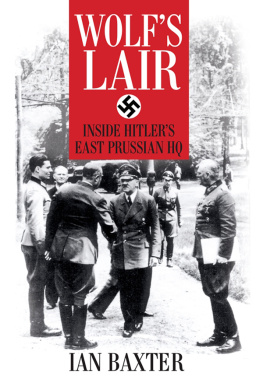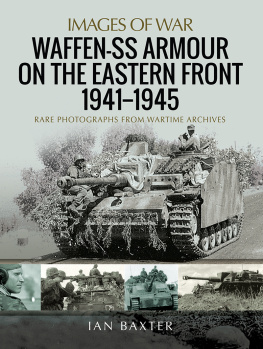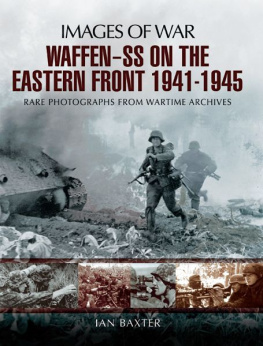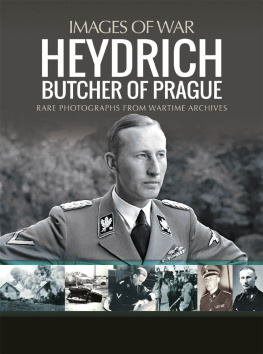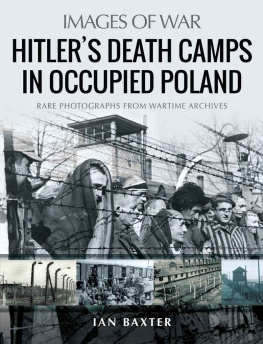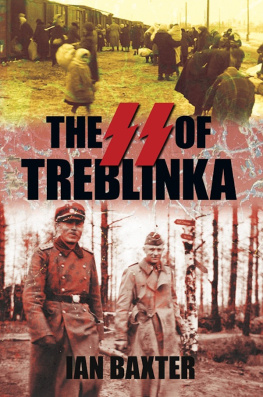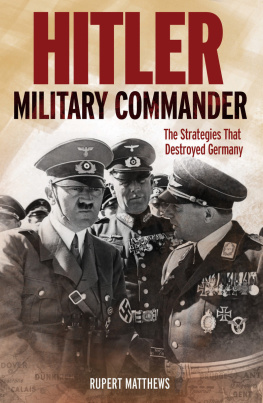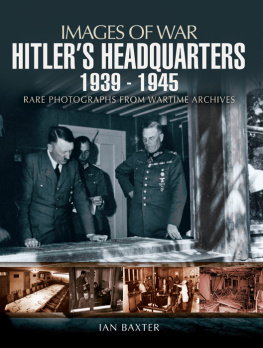WOLFS
LAIR
WOLFS
LAIR
INSIDE HITLERS
EAST PRUSSIAN HQ
IAN BAXTER

Men and wars come and go, but what is left, are the buildings.
Adolf Hitler
First published 2009
The History Press
The Mill, Brimscombe Port
Stroud, Gloucestershire, GL5 2QG
www.thehistorypress.co.uk
This ebook edition first published in 2016
All rights reserved
Ian Baxter, 2009
The right of Ian Baxter to be identified as the Author of this work has been asserted in accordance with the Copyrights, Designs and Patents Act 1988.
This ebook is copyright material and must not be copied, reproduced, transferred, distributed, leased, licensed or publicly performed or used in any way except as specifically permitted in writing by the publishers, as allowed under the terms and conditions under which it was purchased or as strictly permitted by applicable copyright law. Any unauthorised distribution or use of this text may be a direct infringement of the authors and publishers rights, and those responsible may be liable in law accordingly.
EPUB ISBN 978 0 7509 7933 7
Printed in Great Britain
eBook converted by Geethik Technologies
About the Author
Ian Baxter is a military historian who specialises in German twentieth-century military history. He has written more than twenty books including Poland The Eighteen Day Victory March, Panzers In North Africa, The Ardennes Offensive, The Western Campaign, The 12th SS Panzer-Division Hitlerjugend, The Waffen-SS on the Western Front, The Waffen-SS on the Eastern Front, The Red Army At Stalingrad, Elite German Forces of World War II, Armoured Warfare, German Tanks of War, Blitzkrieg, Panzer-Divisions At War, Hitlers Panzers, German Armoured Vehicles of World War Two, Last Two Years of the Waffen-SS At War, German Soldier Uniforms and Insignia, German Guns of the Third Reich, Defeat to Retreat: The Last Years of the German Army At War 19441945, Operation Bagration the destruction of Army Group Centre, German Guns of the Third Reich, Rommel and the Afrika Korps, U-Boat War, and most recently The Sixth Army and the Road to Stalingrad. The SS of Treblinka is a forthcoming History Press title. He has written over one hundred journal articles including Last days of Hitler, Wolfs Lair, Story of the V1 and V2 rocket programme, Secret Aircraft of World War Two, Rommel at Tobruk, Hitlers War with his Generals, Secret British Plans to Assassinate Hitler, SS at Arnhem, Hitlerjugend, Battle Of Caen 1944, Gebirgsjger at War, Panzer Crews, Hitlerjugend Guerrillas, Last Battles in the East, Battle of Berlin, and many more. He has also reviewed numerous military studies for publication, supplied thousands of photographs and important documents to various publishers and film production companies worldwide, and lectures to various schools, colleges and universities throughout the United Kingdom and Ireland.
Acknowledgements
Those of us who write the histories of war know what an arduous task it is to put them together, and without help this project would have been impossible. So I will endeavour to first thank those who shared my research, to briefly name the historians and archivists who guided me, and the friends whose help went beyond the bounds of professional assistance. I first wish to thank my Polish expert and translator Bartlomiej Zoborski. He not only found vital contacts, but revealed valuable information that became an asset in completing my research.
During my ten years of research into Hitlers headquarters, I must also acknowledge David Irving for his help and expert advice. A special debt is due to Dr Hans-Jurgen Kuhn, Professor Peter Hoffmann of McGill University, Montreal, Canada, whose advice and book, Hitlers Personal Security, helped me throughout my research. I wish to thank Dr Andrzei Paczkowski, Fritz T. Stol, and of course Dr Richard Raiber of Hockessin, Delaware, USA, whose diligent and expert advice clarified many issues and diverse opinions.
Thanks also go to Linda Mcfeddon, my German historical diary translator for deciphering many illegible handwritten diaries. As ever, I am much in debt to the staff of the Imperial War Museum in London, archivist Robin Edward Cookson for captured German records at the National Archives USA, Ulrike Talay and Michael Volk at the Intitut fur Zeigeschichte Archiv Munchen, Bundesarchiv Koblenz, and Dr Ritter at the Bundesarchiv Berlin, for their help, advice, access to documents and other important information.
My thanks go to Mr Boguslaw Wrobel of EXPLORATOR in Poland, Michelle Mortimer who was Publishing Manager at the MicroForm in West Yorkshire, England, Professor Dr Hartmut Lehmann of the Max-Planck-Institut Fr Geschichte (since 2007 the Max-Planck-Institut zur Erforschung multireligiser und multiethnischer Gesellschaften), The German Historical Institute in London and the staff at the Colchester Library in England.
I must especially record my appreciation of the kindness of the staff at the Ilford Park residential home in Devon, England, and to W. Jaworski who generously gave his time to translate Polish and Russian documents for me.
To many individuals I owe thanks for their help, personal reminiscence and unfailing encouragement. I have spoken briefly of all those who had some association with my research on this book, but not yet those that actually ventured with me to Poland to see the ruins of the Wolfs Lair. It is with the greatest pleasure that I would like to thank my dear friends Kevin Bowden and Chandran Sivaneson for coming to Poland with me over a three-day period. It was a cold and snowy morning in January 2008 when we arrived in Gdansk airport. Our Polish guide and taxi driver, Elzbieta Giste, took us across northern Poland, and after travelling more than five hours across treacherous roads to the east of the country, we finally arrived safely in the town of Ketzryn (formerly Rastenburg) to begin our research into Hitlers infamous East Prussian headquarters. To both Kevin and Chandran I would like to say a big thank you. Not only were they extremely helpful with their support and advice but they were infinitely patient as they waited for me in the snow, examining each ruined building. My gratitude also goes to Elzbieta Giste who helped us tirelessly with translation and driving us around the Polish countryside.
Preface
This is the special and wonderful property of architecture: when the work has been done, a monument remains. That endures; it is something different from a pair of boots, which can also be made, but which the wearer wears out in a year or two and then throws away. This remains, and through the centuries will bear witness to all those who helped to create it.
Adolf Hitler, following the construction of the Reich Chancellery in January 1939.
I held this ardent belief when I embarked on this study of Hitlers largest wartime headquarters, the Wolfs Lair. Throughout my years of research I saw myself not as an architect concerned with building towering structures, but an historian eager to construct in words a lasting monument to Hitlers Eastern Front headquarters.
The Wolfs Lair (Wolfschanze) was the most important German command post built during the Second World War, and the orders that were sent from these secret headquarters inevitably changed the course of the War. Still to this day, many people persistently cloak these headquarters in an atmosphere of gloom to reinforce the image of the frightening Fhrer who lived there. However, it is my opinion that the legacy left by Hitler at his headquarters is self-evident and requires no exaggerated portrayal. In order to remedy this unnecessary obfuscation I decided to burrow deep and describe events from behind the barbed-wire entanglements of the Wolfs Lair and analyse each unfolding episode through the eyes of Hitler and his staff.
Next page
